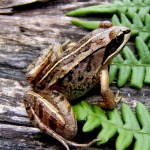by Sim Barrow
It is just after sunset as I make my way through the dense grass and shallow pools at Wilson Springs Preserve in Fayetteville, Arkansas. The thunderstorms from earlier in the day have subsided, and the horizon glows with the remaining light of the day. With clipboard and pencil in hand, I stop at the edge of an embankment and wait. After a few minutes, the relative quiet is interrupted by a chorus of leopard frogs, American toads and spring peepers. These are the sounds that drew me to the site, and are the reason for my evening visit to the Preserve.
Frog and toad activity at Wilson Springs Preserve is no small matter for the Northwest Arkansas Land Trust. Protecting wildlife habitat is one of our highest priorities in our work to conserve the natural landscapes of our region. Whether through conservation easements or by receiving land as a donation, we ensure that those lands will continue to serve as a place for wildlife forever, even as the human population grows.
Of course, seeing the land preserved is just the beginning. With each conserved property we commit to the ongoing stewardship of the land, which includes biomonitoring, or the tracking of native plant and animal species like frogs and toads. The information we gain from biomonitoring is used to inform land management practices like restoration activities and invasive plant removal. It also serves as an indicator of the overall health of the habitat. Because frogs and toads are such great indicator species, it makes sense for the land trust to specifically monitor for them.
For this reason, we are excited to integrate the FrogWatch USA frog monitoring program into our biomonitoring plan. Citizen-science programs are an excellent way to engage with the community and help people enjoy and appreciate the outdoors. It is also a helpful resource for nonprofits like the Northwest Arkansas Land Trust that have limited staff capacity. We look forward to recruiting and training new FrogWatch volunteers in 2017 to help us monitor frogs and toads on some of our properties. It’s also a great opportunity for current volunteers to explore new areas and support local conservation efforts.
Join me and the other NWA Chapter Coordinators this February 25 from 1pm-6pm for the first FrogWatch training workshop of the year. The workshop will be held at the Historic Ozark Mountain Smokehouse (1725 Smokehouse Trail Fayetteville, AR 72701). There will be a special trip to our Wilson Springs Preserve following the workshop, where we will practice the skills taught in the training. We may even hear crawfish frogs making their characteristic “snoring” sound! Contact [email protected] to register for the training.
With your help, we can all protect habitat for frogs and toads in Northwest Arkansas. Thank you, volunteers, for your commitment to frog and toad conservation!


